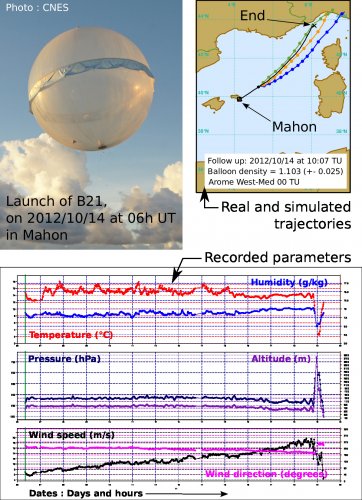Home > Our research topics > Adaptive Observation > Constant level drifting balloons in HyMeX and deployment strategies
by Alexis Doerenbecher and Fabien Bernard
published in the Météo-France 2012 Research Report (ISSN : 2116-438X)
During the Special Observing Period (SOP ) number 1 (SOP1) of HyMeX (Hydrological cycle in the Mediterranean eXperiment), about fifteen Boundary Layer Pressurized Balloons (BLPB) from CNES (French National Center for Space Studies) have been launched from Mahon in Minorca. These balloons collected in-situ measurements of temperature, humidity and pressure and recorded their 3D position all along their isopicnal drift. The wind is derived from the balloon drift. The data are collected in real-time thanks to satellite communications. Filtered data are then disseminated to interested scientists who can use these data in their Numerical Weather Prediction (NWP ) models such as AROME (Météo-France limited-area model, AROME =Application of Research to Operational at Mesoscale) West-Med (AROME western Mediterranean).
The primary objective of these balloons is to monitor the low level air parcels that bring Mediterranean Sea evaporated water into the convective cloud systems that trigger Heavy Precipitation Events (FPE) and possible Flash Floods (FFE) on the elevated grounds that surround the basin (see HyMeX working package 3). The balloons are launched on alert, depending on the weather forecast, the IOP strategy chosen by the HyMeX Operation Center (located in La Grande Motte) and the predicted balloon trajectories that use various NWP systems (IFS, ARPEGE, AROME France and West-Med, PEARP : Ensemble forecast ARPege). The final launch time is a trade-off between the predicted trajectories, local weather constraints (no rain, low or moderate wind) as well as air traffic control.

Picture: Launch of BLPB B21, on the 14/10/2012 about 06 UT on the tarmac of Mahon Aero club in Minorca. The sensors are located within the dedicated shelter at the top and outside the balloon envelope. The housekeeping systems are inside the balloon in the bottom gondola. The equatorial ribbon is a deflector/derivator for rain drops falling from the hydrophobic envelope.
Chart: Real trajectory (black) end predicted trajectories for BLPB B21 starting from a real 3D location (orange) and two others vertical positions (more or less 150 metres in blue and green): this is the trajectory “follow”, which give every 20 minutes a new prediction of the balloon’s future route.
Diagram: Overview of the B21 in-flight collected parameters. This balloon fulfilled its objectives as it entered convective systems close to the French-Italian boarder at 19h15. The final ascent triggers the end of the flight.




